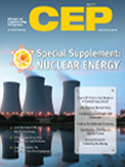
Special Supplement: Nuclear Energy
Prepared in collaboration with AIChE's Energy Advisory Board as part of the Institute's Energy Initiative, this year's energy supplement focuses on nuclear energy.
o Face-Off: (click here to read this article now)
Nuclear Energy: A Vital Component of Our Energy Future
Nuclear power is proven to be safe, and it is our best shot at increasing energy production while reducing CO2 emissions levels.
o Nuclear Renaissance: A Flawed Proposition
Nuclear power has never been safe and it never will be. Efficiency gains and investment in renewable sources of energy will be sufficient to power the planet without resorting to nuclear reactors.
o Nuclear Waste Policy in the United States
The current U.S. reactor fleet produces 2,100-2,400 ton/yr of spent nuclear fuel (SNF). After 50-plus years of nuclear power generation, 64,000 tons of SNF has accumulated in temporary storage at the reactor sites. How did we get where we are, and where do we go from here?
o Nuclear Power: Energy to Produce Liquid Fuels and Chemicals
Using nuclear energy to operate refineries and chemical plants would allow more fossil and biomass resources to be converted to fuel and chemical products.
o Nuclear Power: Fueling the Hydrogen Economy
Nuclear hydrogen might first enter the transportation market to supplement existing fossil resources. In the long-term, it could be a key in the development of a hydrogen economy.
o Developing a Position on Nuclear Power
AIChE's Nuclear Engineering Division recommends expanding the role of nuclear power and closing the nuclear fuel cycle. What are your views?
o Energy Research: Following the Money
Surveys of the energy-related papers presented at AIChE's annual meetings shed light on the funding pathways for energy research by chemical engineers.
Reactions and Separations: Use Oxygen to Improve Combustion and Oxidation
Substituting oxygen for air is often a low-cost, easy-to-implement option that can reduce capital costs, lower emissions, and improve process flexibility and reliability.
Back to Basics: Choosing Specialty Metals for Corrosion-Sensitive Equipment
Specialty metals should be considered for processes that push beyond the corrosion limits of steel. New composites and surface alloy technologies expand the options for defending against corrosion.
News Feature: Radical Designs Boost Resource Efficiency
The top projects in the recent 10xE Design Challenge showcase the best examples of resource-efficient, integrative design from the chemical engineering community.
News: Using Cells to Diagnose Food Allergies More Accurately ... Carbon Nanotubes Improve Power Capacity in Lithium Batteries ... OTC Launches Arctic Technology Conference, Feb. 7-9, 2011, in Houston ... Smarter Self-Healing Concrete Extends the Life of Structures ... Liquid Method Produces Pure Graphene ... New Yeast Ferments More Sugar to Produce More Ethanol ... Chem Economics: Outlook Improves for Chemical Industry Capital Spending.
Plus: Institute News: Director Candidates' Statements ... Bio Beat: Engineering Personalized Medicine ... Process Safety Beacon: Passive Safety Equipment ... What's New ... Product Digest: Valves ... Software & Information Technology ... We're History: Back to the Future -- Revisiting the Chemical Origins of Life Experiment ... and More.
The July 2010 issue of CEP is now available online. AIChE members receive access to CEP, including a searchable archive of issues dating back to 2001, online at http://www.aiche.org/cep.


Comments
I can´t wait to get this in the mail and crack it open! When I am done I am going to leave it in the common area at work - spread some more truth about nuclear energy and try to dispel the rumors and myths people have come to believe to be facts.
This is a new comment on a really old post, but I didn't know where else to put it. It took me a while to get to this issue - my mail is REALLY slow! But a couple of thoughts on this issue. I thought there were some really good ideas and insights. Some exciting possibilities that could greatly improve our energy economy. I like the FaceOff format, especially since so much of these energy debates need to be looked logically from more than one point of view. But maybe there could be some more work done on reviewing these articles before print or more information on the sourcing of "facts" used. The 'con'-nuclear article states that at 66g CO2/kWh ranks nuclear power above every single renewable source (p31), while on the opposite page (p30) is a chart with nuclear looking like something <50g CO2/kWh with PV over 100g CO2. I can see there might be differences in CO2 calculations and nuclear could be between 40-70g CO2. But in order for these 2 statements to remain true the swing on PV emissions is almost twice bigger and in the opposite direction. It would be useful to know where these numbers come from to help evaluate each position.